Abstract
Serotonin and substance P circulate in high concentrations in patients with the carcinoid syndrome. These studies were performed to evaluate the effects of intravenous infusions of serotonin and substance P to reproduce carcinoid levels of these agents on central hemodynamics, regional blood flow (using the radioactive microsphere technique), and endogenous hormone release. Serotonin did not affect mean arterial pressure but it significantly increased cardiac output, decreased systematic vascular resistance, and redistributed regional blood flow, increasing blood flow to the heart, adrenals, fundus, and antrum. Substance P significantly decreased mean arterial pressure and systemic vascular resistance, increased cardiac output, and increased blood flow to adrenal, fundus, antrum, liver, and all muscular layers of the stomach and small bowel. Neither serotonin nor substance P affected skin blood flow, nor altered circulating levels of glucose, insulin, or gastrin. Although both of these agents seem to participate in the pathogenesis of the carcinoid syndrome, our studies suggest that it is not possible to ascribe all the hemodynamic abnormalities to either.
Full text
PDF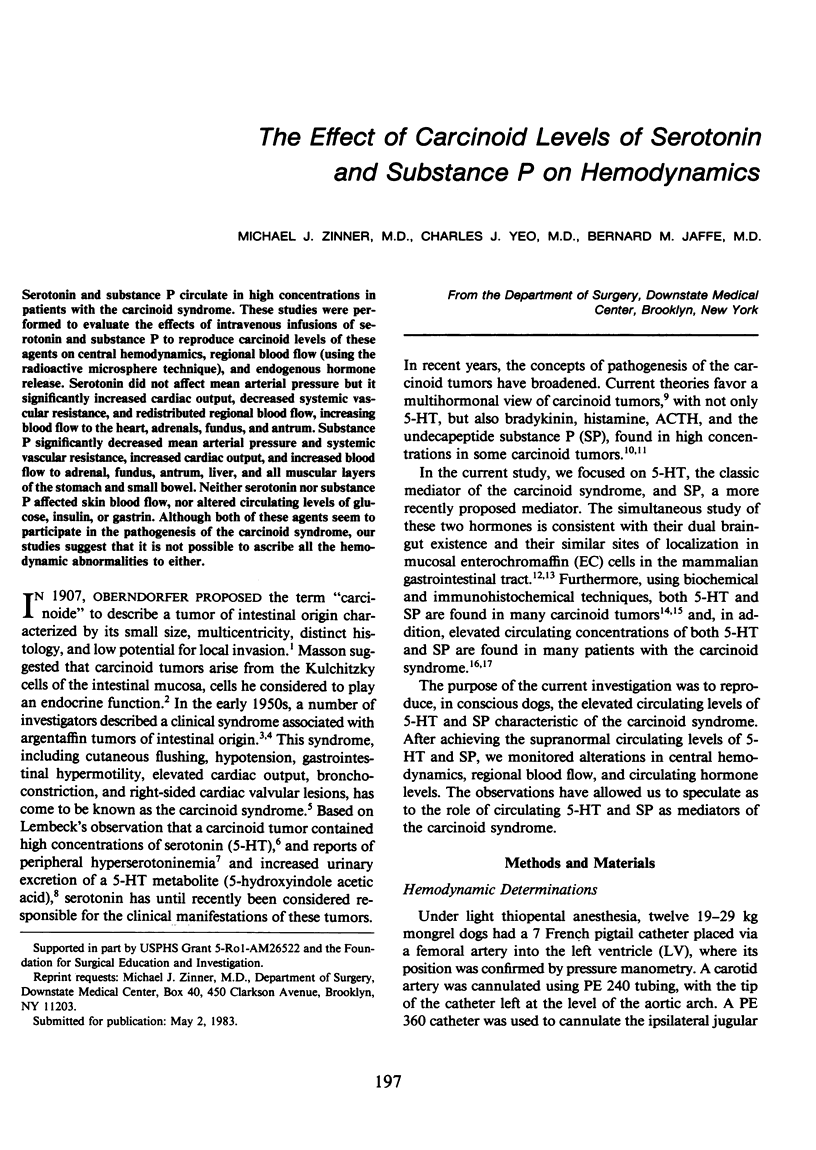
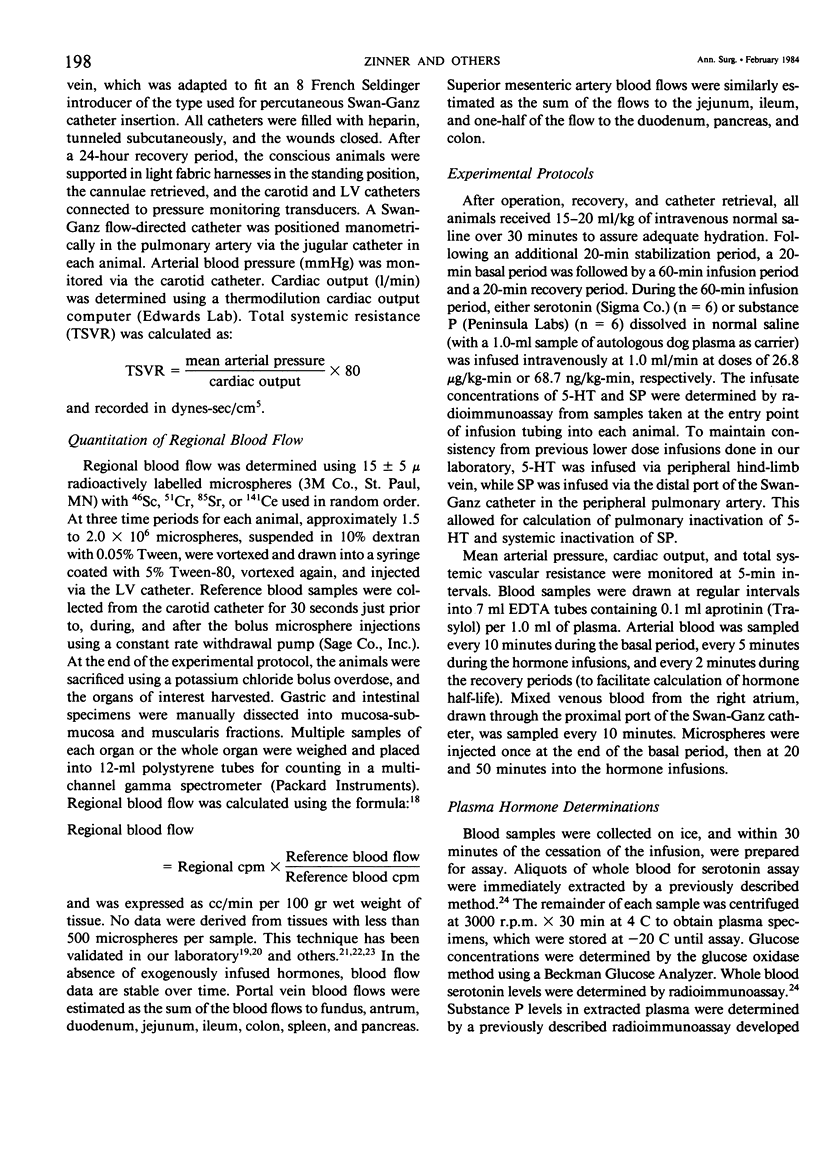
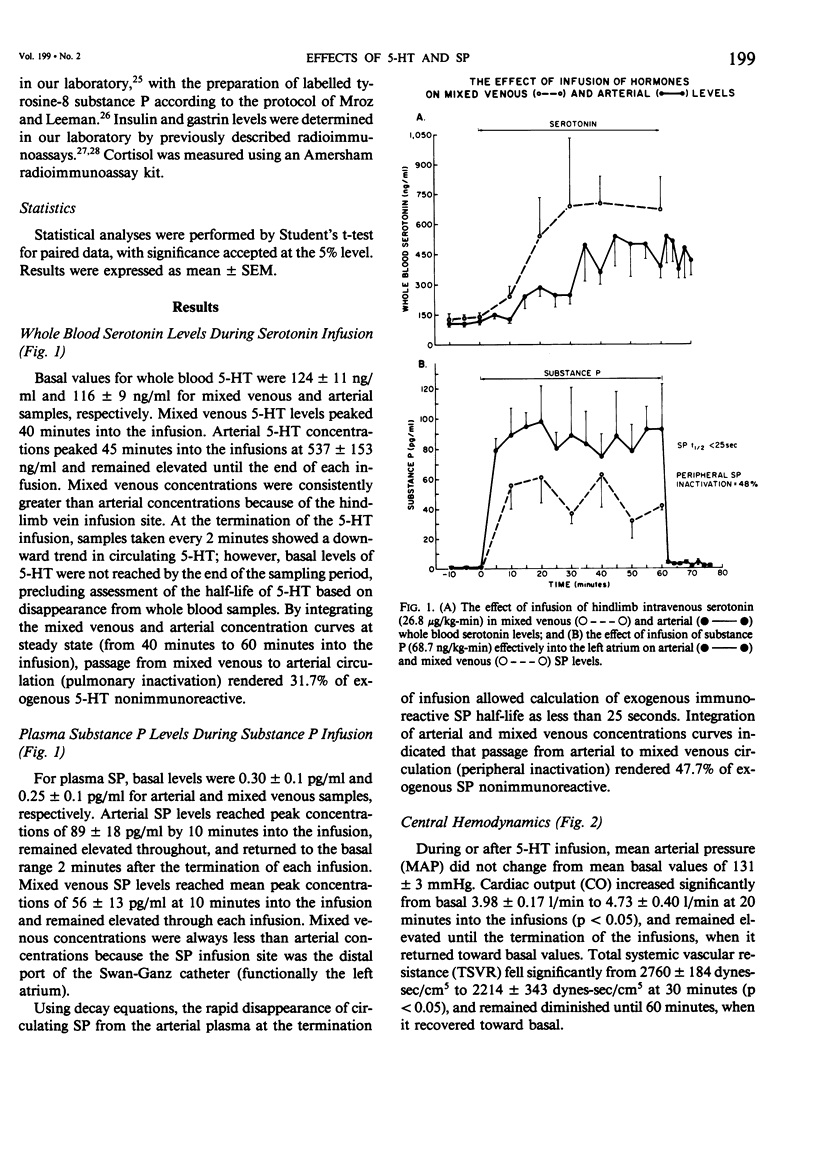
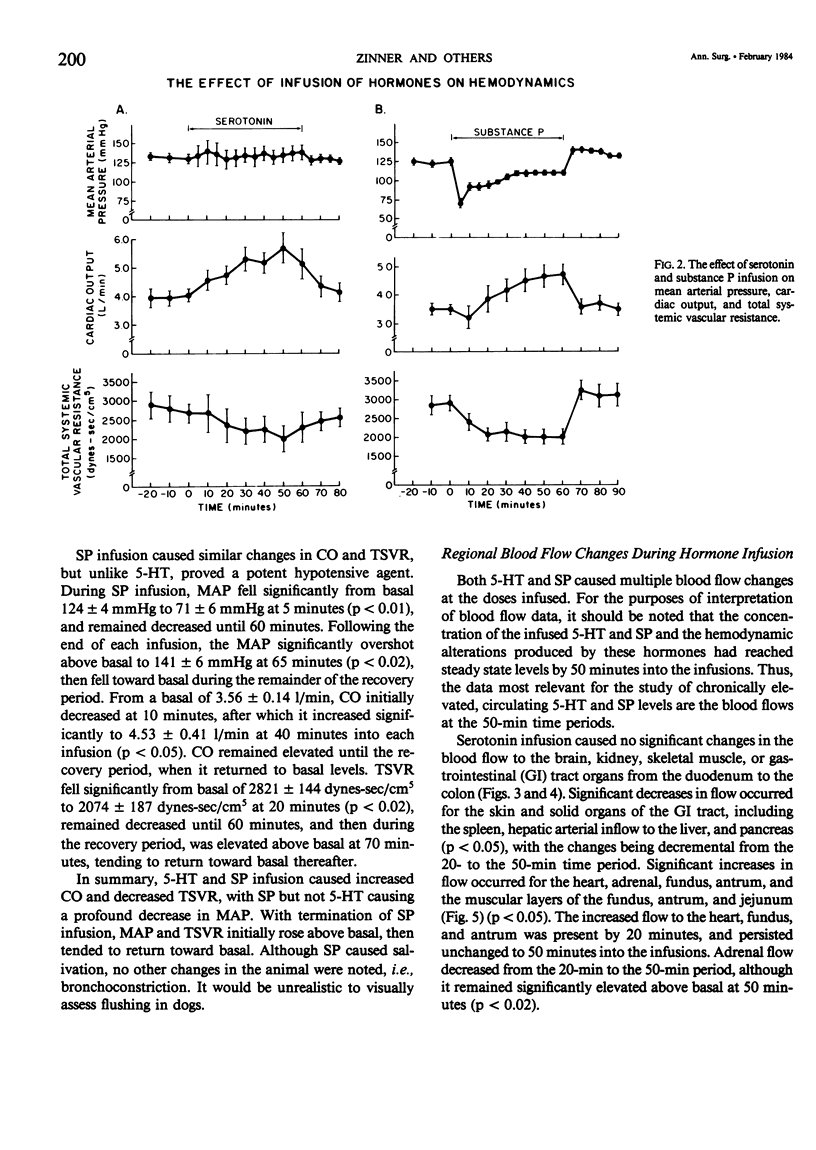

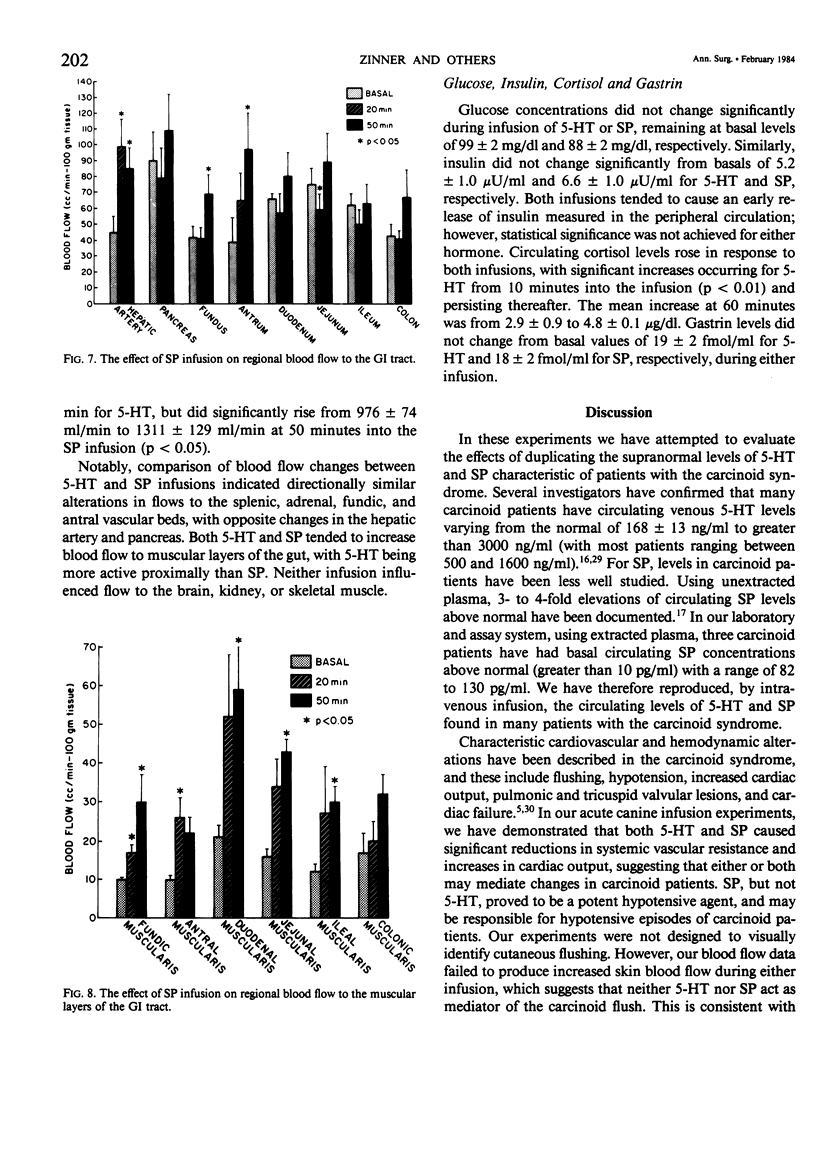
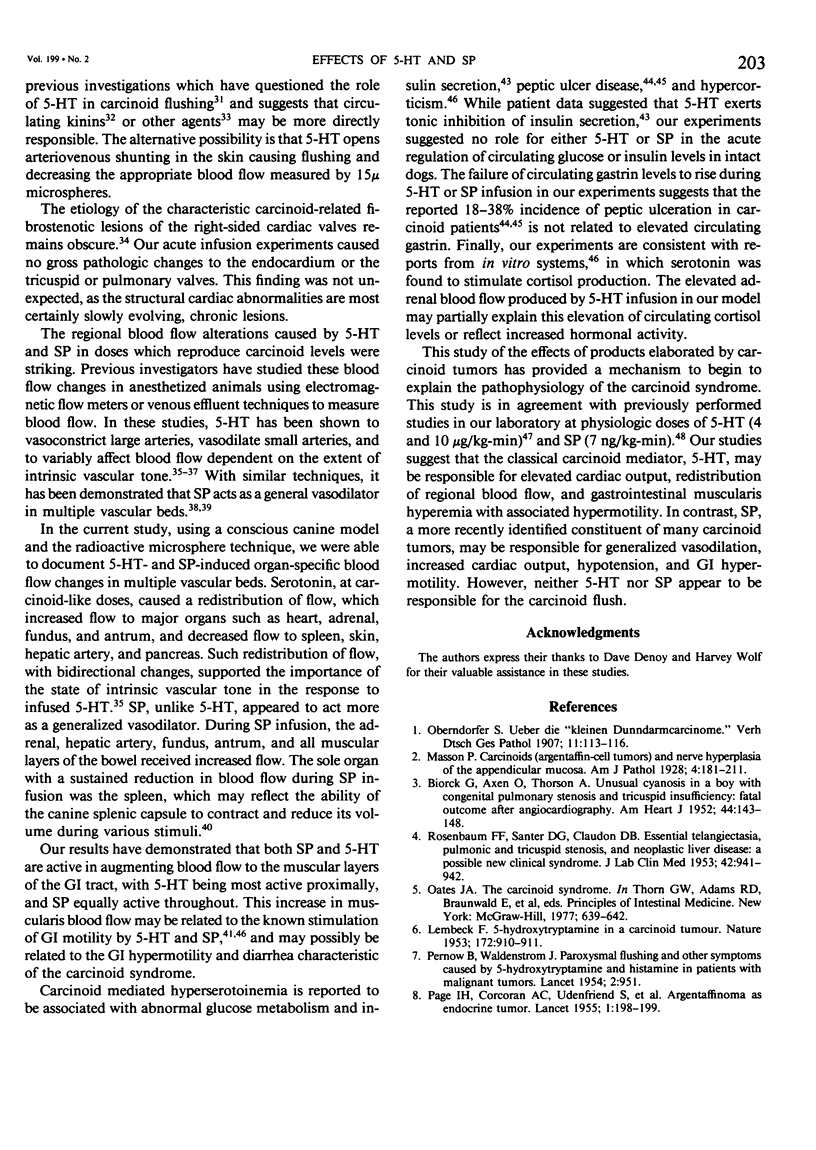
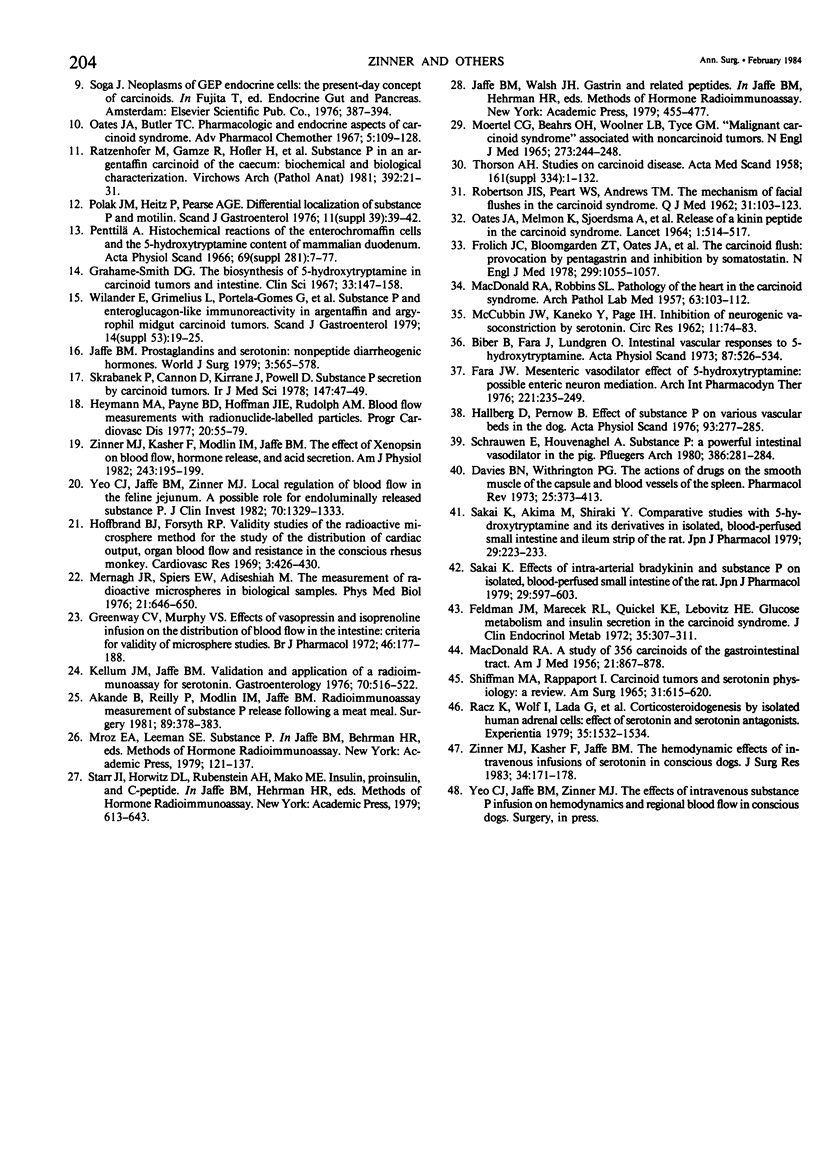
Selected References
These references are in PubMed. This may not be the complete list of references from this article.
- Akande B., Reilly P., Modlin I. M., Jaffe B. M. Radioimmunoassay measurement of substance P release following a meat meal. Surgery. 1981 Mar;89(3):378–383. [PubMed] [Google Scholar]
- BIORCK G., AXEN O., THORSON A. Unusual cyanosis in a boy with congenital pulmonary stenosis and tricuspid insufficiency. Fatal outcome after angiocardiography. Am Heart J. 1952 Jul;44(1):143–148. doi: 10.1016/0002-8703(52)90182-8. [DOI] [PubMed] [Google Scholar]
- Biber B., Fara J., Lundgren O. Intestinal vascular responses to 5-hydroxytryptamine. Acta Physiol Scand. 1973 Apr;87(4):526–534. doi: 10.1111/j.1748-1716.1973.tb05419.x. [DOI] [PubMed] [Google Scholar]
- Davies B. N., Withrington P. G. The actions of drugs on the smooth muscle of the capsule and blood vessels of the spleen. Pharmacol Rev. 1973 Sep;25(3):373–413. [PubMed] [Google Scholar]
- Fara J. W. Mesenteric vasodilator effect of 5-hydroxytryptamine: possible enteric neuron mediation. Arch Int Pharmacodyn Ther. 1976 Jun;221(2):235–249. [PubMed] [Google Scholar]
- Feldman J. M., Marecek R. L., Quickel K. E., Jr, Lebovitz H. E. Glucose metabolism and insulin secretion in the carcinoid syndrome. J Clin Endocrinol Metab. 1972 Aug;35(2):307–311. doi: 10.1210/jcem-35-2-307. [DOI] [PubMed] [Google Scholar]
- Frölich J. C., Bloomgarden Z. T., Oates J. A., McGuigan J. E., Rabinowitz D. The carcinoid flush. Provocation by pentagastrin and inhibition by somatostatin. N Engl J Med. 1978 Nov 9;299(19):1055–1057. doi: 10.1056/NEJM197811092991908. [DOI] [PubMed] [Google Scholar]
- Grahame-Smith D. G. The biosynthesis of 5-hydroxytryptamine in carcinoid tumours and intestine. Clin Sci. 1967 Aug;33(1):147–158. [PubMed] [Google Scholar]
- Greenway C. V., Murthy V. S. Effects of vasopressin and isoprenaline infusions on the distribution of blod flow in the intestine; criteria for the validity of microsphere studies. Br J Pharmacol. 1972 Oct;46(2):117–188. doi: 10.1111/j.1476-5381.1972.tb06863.x. [DOI] [PMC free article] [PubMed] [Google Scholar]
- Hallberg D., Pernow B. Effect of substance P on various vascular beds in the dog. Acta Physiol Scand. 1975 Feb;93(2):277–285. doi: 10.1111/j.1748-1716.1975.tb05816.x. [DOI] [PubMed] [Google Scholar]
- Heymann M. A., Payne B. D., Hoffman J. I., Rudolph A. M. Blood flow measurements with radionuclide-labeled particles. Prog Cardiovasc Dis. 1977 Jul-Aug;20(1):55–79. doi: 10.1016/s0033-0620(77)80005-4. [DOI] [PubMed] [Google Scholar]
- Hoffbrand B. I., Forsyth R. P. Validity studies of the radioactive microsphere method for the study of the distribution of cardiac output, orn blood flow, and resistance in the conscious rhesus monkey. Cardiovasc Res. 1969 Oct;3(4):426–432. doi: 10.1093/cvr/3.4.426. [DOI] [PubMed] [Google Scholar]
- Jaffe B. M. Prostaglandins and serotonin: nonpeptide diarrheogenic hormones. World J Surg. 1979 Sep 20;3(5):565–578. doi: 10.1007/BF01654761. [DOI] [PubMed] [Google Scholar]
- Kellum J. M., Jaffe B. M. Validation and application of a radioimmunoassay for serotonin. Gastroenterology. 1976 Apr;70(4):516–522. [PubMed] [Google Scholar]
- MACDONALD R. A. A study of 356 carcinoids of the gastrointestinal tract; report of four new cases of the carcinoid syndrome. Am J Med. 1956 Dec;21(6):867–878. doi: 10.1016/0002-9343(56)90101-2. [DOI] [PubMed] [Google Scholar]
- MACDONALD R. A., ROBBINS S. L. Pathology of the heart in the carcinoid syndrome; a comparative study. AMA Arch Pathol. 1957 Feb;63(2):103–112. [PubMed] [Google Scholar]
- Masson P. Carcinoids (Argentaffin-Cell Tumors) and Nerve Hyperplasia of the Appendicular Mucosa. Am J Pathol. 1928 May;4(3):181–212.19. [PMC free article] [PubMed] [Google Scholar]
- Mernagh J. R., Spiers E. W., Adiseshiah M. The measurement of radioactive microspheres in biological samples. Phys Med Biol. 1976 Jul;21(4):646–650. doi: 10.1088/0031-9155/21/4/015. [DOI] [PubMed] [Google Scholar]
- OATES J. A., MELMON K., SJOERDSMA A., GILLESPIE L., MASON D. T. RELEASE OF A KININ PEPTIDE IN THE CARCINOID SYNDROME. Lancet. 1964 Mar 7;1(7332):514–517. doi: 10.1016/s0140-6736(64)92907-1. [DOI] [PubMed] [Google Scholar]
- Oates J. A., Butler T. C. Pharmacologic and endocrine aspects of carcinoid syndrome. Adv Pharmacol. 1967;5:109–128. doi: 10.1016/s1054-3589(08)60656-0. [DOI] [PubMed] [Google Scholar]
- PAGE I. H., CORCORAN A. C., UDENFRIEND S., SZOEDSMA A., WEISSBACH H. Argentaffinoma as endocrine tumour. Lancet. 1955 Jan 22;268(6856):198–199. doi: 10.1016/s0140-6736(55)91924-3. [DOI] [PubMed] [Google Scholar]
- PERNOW B., WALDENSTROM J. Paroxysmal flushing and other symptoms caused by 5-hydroxytryptamine and histamine in patients with malignant tumours. Lancet. 1954 Nov 6;267(6845):951–951. doi: 10.1016/s0140-6736(54)92559-3. [DOI] [PubMed] [Google Scholar]
- Penttilä A. Histochemical reactions of the enterochromaffin cells and the 5-hydroxytryptamine content of the mammalian duodenum. Acta Physiol Scand Suppl. 1966;281:1–77. [PubMed] [Google Scholar]
- Polak J. M., Heitz P., Pearse A. G. Differential localisation of substance P and motilin. Scand J Gastroenterol Suppl. 1976;39:39–42. [PubMed] [Google Scholar]
- ROBERTSON J. I., PEART W. S., ANDREWS T. M. The mechanism of facial flushes in the carcinoid syndrome. Q J Med. 1962 Jan;31:103–123. [PubMed] [Google Scholar]
- Ratzenhofer M., Gamse R., Höfler H., Auböck L., Popper H., Pohl P., Lembeck F. Substance P in the argentaffin carcinoid of the caecum: biochemical and biological characterization. Virchows Arch A Pathol Anat Histol. 1981;392(1):21–31. doi: 10.1007/BF00430545. [DOI] [PubMed] [Google Scholar]
- Rácz K., Wolf I., Kiss R., Lada G., Vida S., Gláz E. Corticosteroidogenesis by isolated human adrenal cells: effect of serotonin and serotonin antagonists. Experientia. 1979 Nov 15;35(11):1532–1534. doi: 10.1007/BF01962830. [DOI] [PubMed] [Google Scholar]
- Sakai K., Akima M., Shiraki Y. Comparative studies with 5-hydroxytryptamine and its derivatives in isolated, blood-perfused small intestine and ileum strip of the rat. Jpn J Pharmacol. 1979 Apr;29(2):223–233. doi: 10.1254/jjp.29.223. [DOI] [PubMed] [Google Scholar]
- Sakai K. Effects of intra-arterial bradykinin and substance P on isolated, blood-perfused small intestine of the rat. Jpn J Pharmacol. 1979 Aug;29(4):597–603. doi: 10.1254/jjp.29.597. [DOI] [PubMed] [Google Scholar]
- Schrauwen E., Houvenaghel A. Substance P: a powerful intestinal vasodilator in the pig. Pflugers Arch. 1980 Aug;386(3):281–284. doi: 10.1007/BF00587480. [DOI] [PubMed] [Google Scholar]
- Shiffman M. A., Rappaport I. Carcinoid tumors and serotonin physiology: a review. Am Surg. 1965 Oct;31(10):615–620. [PubMed] [Google Scholar]
- Skrabanek P., Cannon D., Kirrane J., Powell D. Substance P secretion by carcinoid tumours. Ir J Med Sci. 1978 Feb;147(2):47–49. doi: 10.1007/BF02939369. [DOI] [PubMed] [Google Scholar]
- THORSON A. H. Studies on carcinoid disease. Acta Med Scand Suppl. 1958;334:1–132. [PubMed] [Google Scholar]
- Wilander E., Grimelius L., Portela-Gomes G., Lundqvist G., Skoog V., Westermark P. Substance P and enteroglucagon-like immunoreactivity in argentaffin and argyrophil midgut carcinoid tumours. Scand J Gastroenterol Suppl. 1979;53:19–25. [PubMed] [Google Scholar]
- Yeo C. J., Jaffe B. M., Zinner M. J. Local regulation of blood flow in the feline jejunum. A possible role for endoluminally released substance P. J Clin Invest. 1982 Dec;70(6):1329–1333. doi: 10.1172/JCI110735. [DOI] [PMC free article] [PubMed] [Google Scholar]
- Zinner M. J., Kasher F., Jaffe B. M. The hemodynamic effects of intravenous infusions of serotonin in conscious dogs. J Surg Res. 1983 Feb;34(2):171–178. doi: 10.1016/0022-4804(83)90057-4. [DOI] [PubMed] [Google Scholar]


